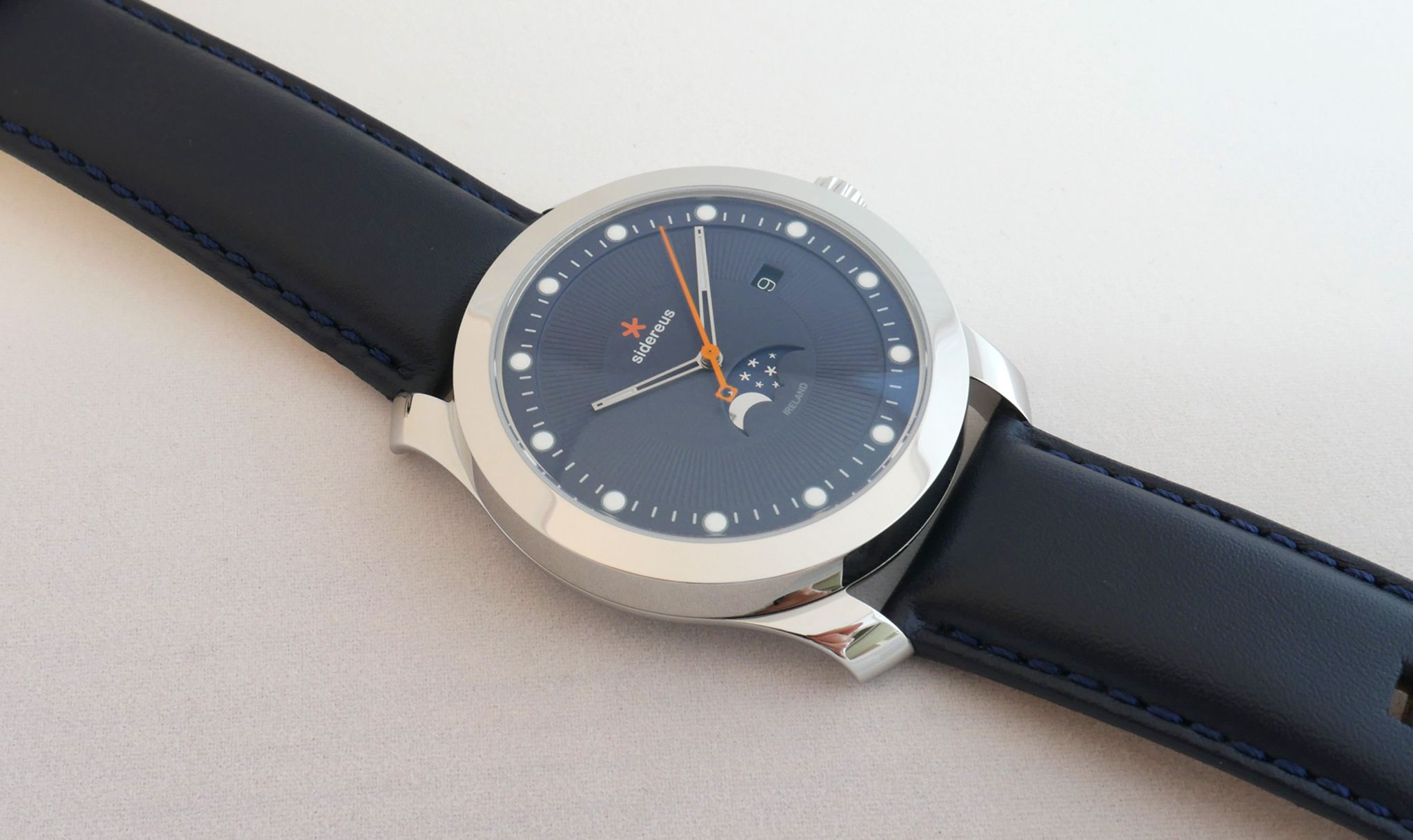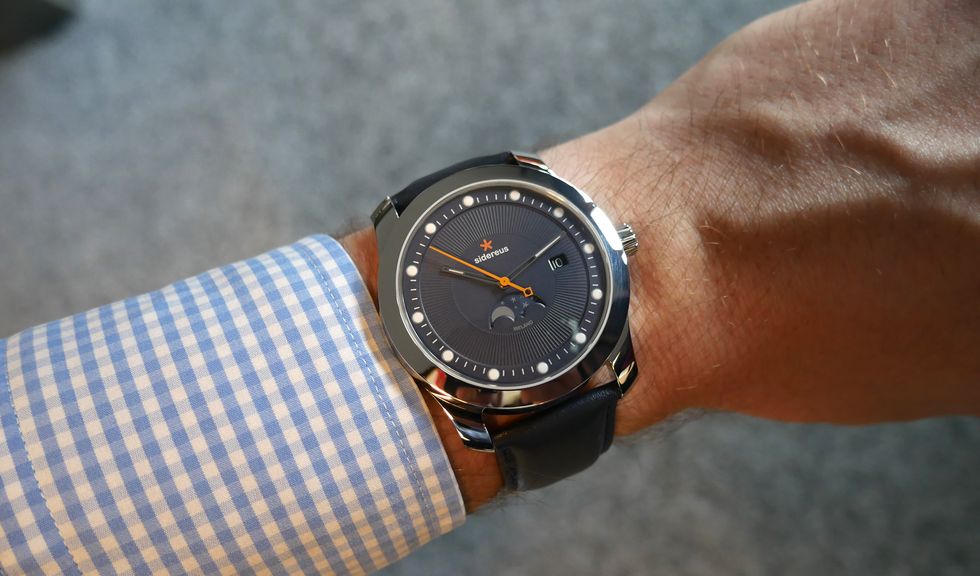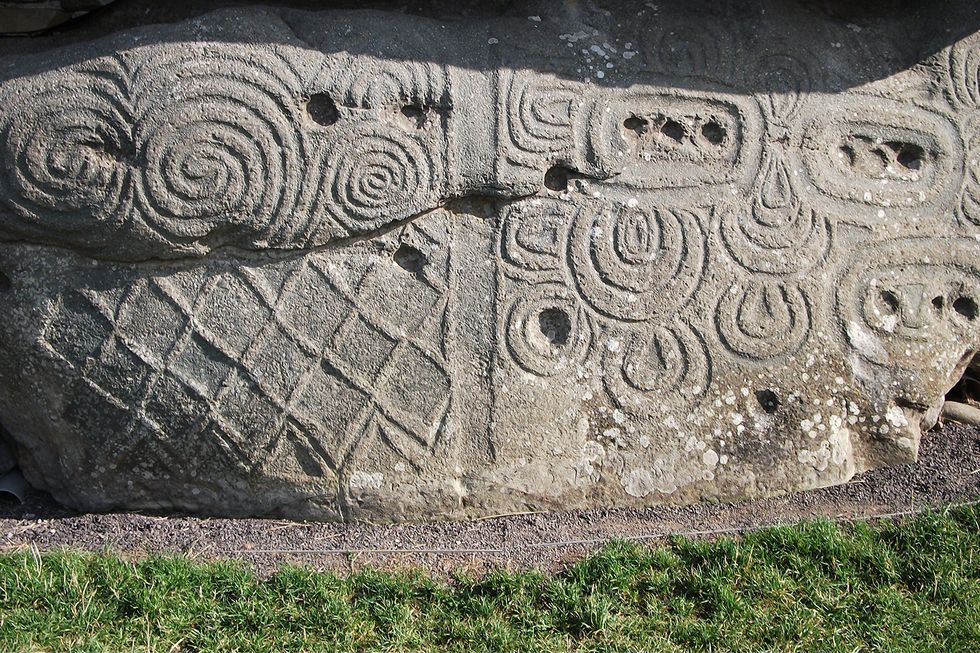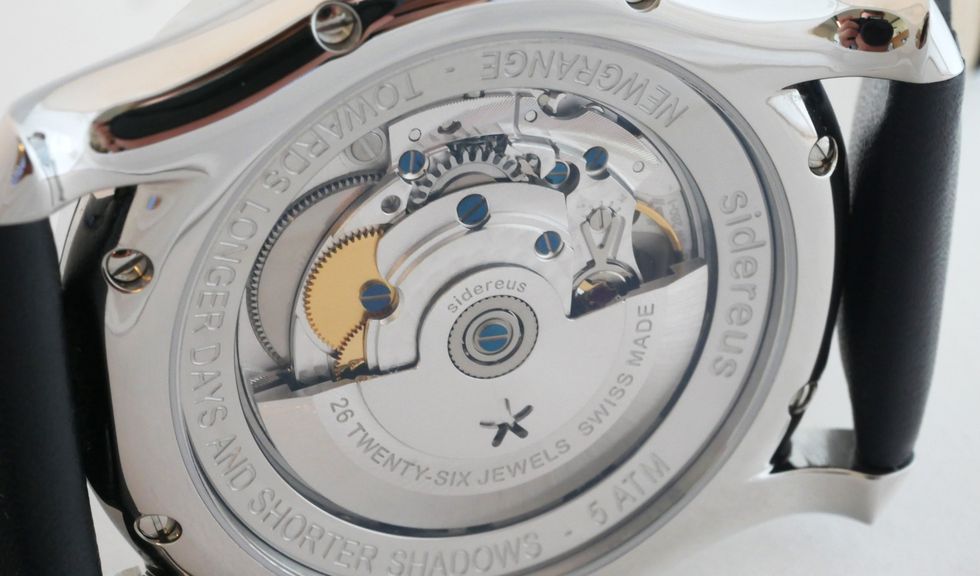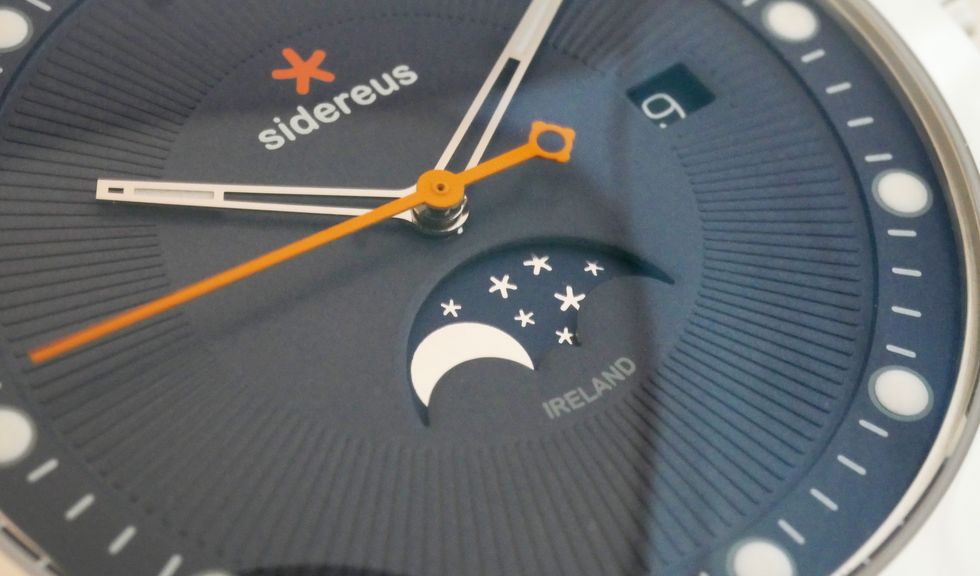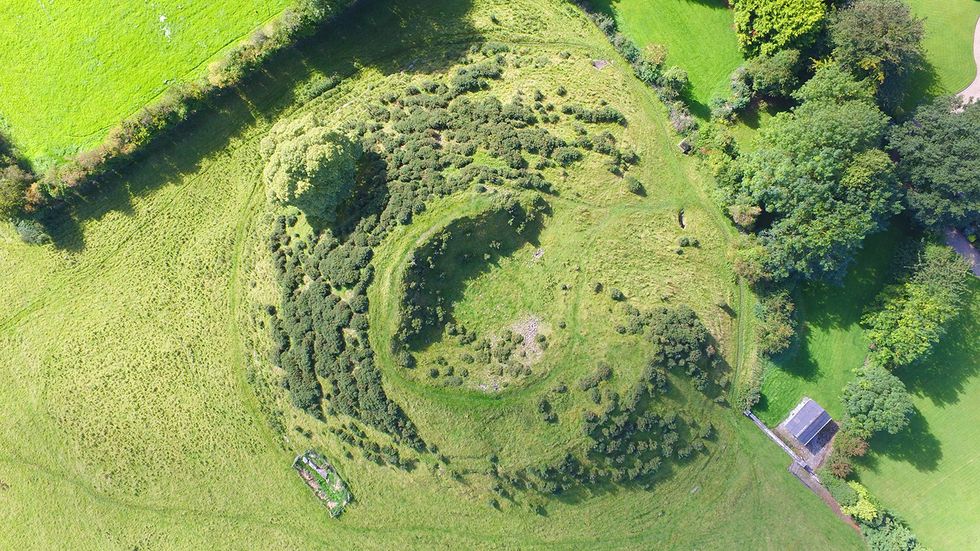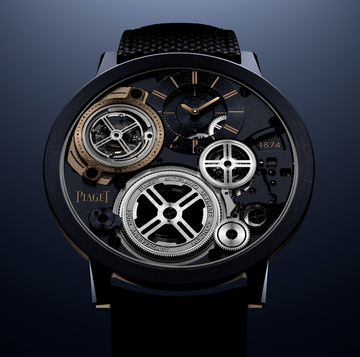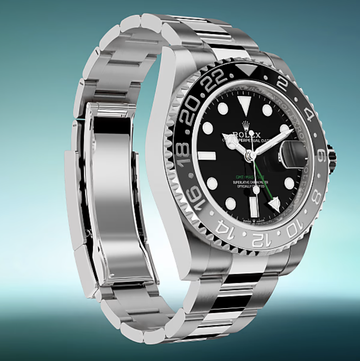To look at the Sidereus Newgrange simply on its own merits as a watch, you would see a 44mm watch in polished stainless steel, with a wide bezel that surrounds a dark, blue-grey dial. Twelve luminous dot hour markers, semi-stencilled hour and minute hands, a moonphase indicator in the six o’clock position, and the most immediately standout feature, a bright orange second hand that matches the five-armed star logo.
Pick it up and you’ll notice the scalloped, sharply curved lugs – actually part of a monobloc caseback – screw-down crown, sapphire caseback (through which, a Sellita SW-280 calibre) and if you’re in a really attentive frame of mind, the fact that it has a custom designed Sidereus buckle rather than an off-the-shelf number.
That would probably be about where the process would end. It’s a handsome watch in a pretty straightforward sense, vaguely modern in appearance but in all the important ways, a traditional watch.
To fully understand the Newgrange, and all the design choices that have gone into it, you have to understand where it comes from. That sounds like the kind of thing marketeers always say, but I’ll be honest, it really does matter here.
Sidereus – the name is Latin for star – is the project of Bryan Leech and Martin Marley, two product designers from Ireland. Both have more than 35 years’ experience as designers, working for everyone from tech firms to interiors, financial services to overseas development programmes, and since 1994 Leech has lectured at the Institute of Technology in Carlow.
A 2014 talk at SalonQP, entitled “Horology: A child of Astronomy”, delivered by the Fondation de la Haute Horlogerie’s in-house historian Gregory Gardinetti, was the spark that turned a personal interest in watches into a professional one. As Leech tells it, “One of the first images shown during this talk was a photo of Newgrange, the Neolithic monument that marks the sidereal year; the time taken for the sun to return to the same position in the sky when observed from Earth. Gardinetti proposed that Newgrange should be considered one of the oldest ‘timepieces’ in the world.
On my return to Ireland I set about developing a brief to design a watch honouring our Neolithic ancestors’ contribution to the science of horology and, in doing so, I hoped to celebrate the very origins of horology and the marking of time in Ireland for over 5,000 years."
Leech finished his design in 2015, and was encouraged to put it into production by Giles Ellis of Schofield – who saw it at an exhibition curated by Leech and Marley. In March 2019 the production ready watches were launched. They have been designed, named and decorated in a very specific homage to Ireland’s Brú na Bóinne prehistoric tombs, of which Newgrange is the largest and best-known – often claimed as Ireland’s greatest national monument. Older than Stonehenge and far more complex, Newgrange is five miles from Drogheda, on the north side of the river Boyne. The other two tombs are Knowth and Dowth, each with their own significance and character – as a result, Sidereus’s three models are named Newgrange, Knowth and Dowth. Knowth and Dowth watches are produced in time-only versions, while Newgrange is offered as a time-only or moonphase design. As you can already see, it’s the moonphase version of Newgrange that we’ve been spending some time with.
So how do these ancient burial sites relate to timekeeping? Newgrange, while primarily a burial chamber, is also a solar edifice, constructed and oriented such that on the day of the winter solstice, the rising sun shines through an aperture in the roof to illuminate the inner chamber (for exactly 17 minutes). The watch’s unusual case profile takes inspiration from the side elevation of the burial mound (also known as the tumulus) at Newgrange. The orange second hand represents the light of the winter solstice sunrise travelling down the passage and illuminating the inner chamber, which itself is represented by the cruciform detail on the counterweight of the hand.
The watches – probably to their credit – have not been given any decoration that overtly references the ancient Celtic art of the Brú na Bóinne complex. But the case finishing given to the Knowth and Dowth watches do have relevance; Knowth as a monument bears inscriptions that represent the solar system and constellations, so the watches have an ion-plated grey finish intended to evoke the idea of space. Dowth translates as “the dark place”, explaining the decision to give the watch a black finish.
On the caseback, you’ll find a sapphire display window. The movements are Sellita, with custom rotors and a basic level of finishing. Around the movement is a spacer ring, which gives Sidereus space for each watch to bear an engraving that speaks to the overall inspiration for the watch. Here it reads “Towards longer days and shorter shadows”. Part of me is surprised to see a display caseback – the concept behind Sidereus’s watches sounds like it could have lent itself to an interesting engraving that continues the celestial theme more overtly than on the dial. And on a basic level, it reduces your costs as a watchmaker – which, when the movement is no great shakes to gaze at, does make some sense. I’m aware that a lot of watch brands feel they need a sapphire caseback to keep up with the Joneses, but when you’re an indie start-up making no more than 50 pieces of each design, I’d be surprised if it’s a deal-breaker.
I think there are some interesting ideas at work here. The watches began life with a strong concept behind them and the way Sidereus has been able to translate that Neolithic shape into a watch case that’s different from anything else on the market, works on its own merits without the backstory, and is uncompromisingly faithful to the original idea is impressive. Like the monument it’s based on it has a big, blunt, slab-like quality that makes a real impact. That’s not to say the watch feels basic – the single-piece caseback and lugs have a curvature to them that adds sophistication (nothing here is off-the-shelf) and just as importantly, comfort.
The lack of case detailing is tempered by the dial, which combines three stepped levels with a radial texture and, on our review model, a moonphase indicator at six o’clock as well as the date window at three. Even with the extra complication, however, it’s hard to escape the fact that it’s a big dial, and this brings us to an observation that’s common to a lot of indie watch brands.
When you opt for a large case diameter, as Sidereus has, and combine that with one of the readily-available movements from Switzerland (or elsewhere), some design choices are made for you. The use of Sellita’s SW280 moonphase calibre, a 25.6mm movement in a 44mm case means that the date is a long way inside the minute track, and the moonphase sits almost uncomfortably close to the central pinion. This isn’t a raging criticism – Sidereus will have wanted the case size for the reasons I mentioned earlier, and using a larger movement would have been impractical. But for me, it was something that once seen, was hard to un-see.
What I’m really not so sure of is how I feel about Sidereus’s overall character. The story is rooted in ancient Irish archaeology and civilisation’s most basic horology; the design has an obvious link to that, but only via that silhouette. The actual shape of the case, either in brushed or polished steel, grey or black coatings, feels distinctly 20th century – as do those stencil hour and minute hands, one of my favourite details on the whole watch – yet the seconds hand adds stylised Celtic to the mix. The hour markers can be interpreted as celestial in the context of the watch’s overall story, but at a glance they say ‘dive watch’.
Last of all, I feel that the logo and typography are uncomfortably mass-market-modern for a luxury watch – the use of a soft and cuddly sans serif in all lower case, together with the rounded, five-pointed star all feels like a design that’s more at home on an app or software provider than a mechanical watch. If Sidereus was making a concerted pitch to woo young buyers, I’d feel differently, and of course not all Irish watches have to go down the McGonigle route. And goodness knows a lot of Swiss logos are groaning under the weight of their own pomposity, but I think there’s a third – or fourth – way to be found.
That may sound like I’ve really laid into the Newgrange, but that wasn't the intention. Adding something new to the world of watch design is never easy, and Sidereus has come up with something original. As I said, a maximum of 50 pieces of each edition will be made, so we’re talking about something that will hold a special appeal for a small number of people. It doesn’t have to sit in a department store window and justify itself against a TAG Heuer or Omega. Ireland’s ancient horological history is worth celebrating, and if the romance of owning something that connects – no matter how loosely – with 5,000 year old timekeeping appeals, then you may find the Newgrange speaks to you.
Like this article? Sign up to our newsletter to get more articles like this delivered straight to your inbox.
